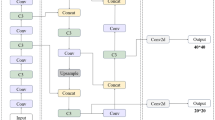Abstract
In today’s world, the utilization of a large number of vehicles has led to congested traffic conditions and an increase in accidents. These issues are considered primary problems in the transportation field. Therefore, there is a pressing need to develop a novel method for monitoring traffic. To address this, we propose a new model called the residual faster recurrent convolutional (RFRC) algorithm. While the proposed model achieves good detection accuracy, it must also meet the demands of real-life scenarios. In this approach, the ResNet-50 model is combined with the faster recurrent-based convolutional neural network (FRCNN) to enable the detection of autonomous vehicles. We utilize the dung beetle optimizer (DBO) with a crossover strategy for feature selection, focusing on selecting relevant features for analysis. To validate the effectiveness of the proposed RFRC method, we conduct experiments using two datasets: the KITTI dataset and the COCO2017 dataset. The evaluation of the RFRC model is performed using various measures, including f1-score, precision, recall, accuracy, and specificity, on both datasets. The proposed RFRC model outperforms both datasets and attains better results in autonomous vehicle detection.












Similar content being viewed by others
Explore related subjects
Discover the latest articles and news from researchers in related subjects, suggested using machine learning.Data availability
Data sharing is not applicable to this article as no new data were created or analyzed in this study.
Code availability
Not applicable.
References
Ravi N, El-Sharkawy M (2022) Real-time embedded implementation of improved object detector for resource-constrained devices. J Low Power Electron Appl 12(2):21. https://doi.org/10.3390/jlpea12020021
Fan YC, Yelamandala CM, Chen TW, Huang CJ (2021) Real-time object detection for lidar based on ls-r-yolov4 neural network. J Sens 2021:1–11. https://doi.org/10.1155/2021/5576262
Mauri A, Khemmar R, Decoux B, Haddad M, Boutteau R (2021) Real-time 3D multi-object detection and localization based on deep learning for road and railway smart mobility. J Imag 7(8):145. https://doi.org/10.3390/jimaging7080145
Ravindran R, Santora MJ, Jamali MM (2020) Multi-object detection and tracking, based on DNN, for autonomous vehicles: a review. IEEE Sens J 21(5):5668–5677. https://doi.org/10.1109/JSEN.2020.3041615
Ji Q, Dai C, Hou C, Li X (2021) Real-time embedded object detection and tracking system in Zynq SoC. EURASIP J Image Video Process 2021:1–16. https://doi.org/10.1186/s13640-021-00561-7
Abdulghafoor NH, Abdullah HN (2021) Real-time moving objects detection and tracking using deep-stream technology. J Eng Sci Technol 16(1):194–208
Liu Z, Cai Y, Wang H, Chen L (2021) Surrounding objects detection and tracking for autonomous driving using LiDAR and radar fusion. Chin J Mech Eng 34:1–12. https://doi.org/10.1186/s10033-021-00630-y
Janowicz K, Gao S, McKenzie G, Hu Y, Bhaduri B (2020) GeoAI: spatially explicit artificial intelligence techniques for geographic knowledge discovery and beyond. Int J Geogr Inf Sci 34(4):625–636. https://doi.org/10.1080/13658816.2019.1684500
Ramachandran A, Sangaiah AK (2021) A review on object detection in unmanned aerial vehicle surveillance. Int J Cogn Comput Eng 2:215–228. https://doi.org/10.1016/j.ijcce.2021.11.005
Masmoudi M, Friji H, Ghazzai H, Massoud Y (2021) A reinforcement learning framework for video frame-based autonomous car-following. IEEE Open J Intell Transp Syst 2:111–127. https://doi.org/10.1109/OJITS.2021.3083201
Daniel A, Subburathinam K, Anand Muthu B, Rajkumar N, Kadry S, Kumar Mahendran R, Pandian S (2020) Procuring cooperative intelligence in autonomous vehicles for object detection through data fusion approach. IET Intel Transp Syst 14(11):1410–1417
Wang R, Wang Z, Xu Z, Wang C, Li Q, Zhang Y, Li H (2021) A real-time object detector for autonomous vehicles based on YOLOv4. Comput Intell Neurosci. https://doi.org/10.1155/2021/9218137
Haris M, Glowacz A (2021) Road object detection: a comparative study of deep learning-based algorithms. Electronics 10(16):1932. https://doi.org/10.3390/electronics10161932
Ghazal TM, Said RA, Taleb N (2021) Internet of vehicles and autonomous systems with AI for medical things. Soft Comput. 1–13
Azam S, Munir F, Sheri AM, Kim J, Jeon M (2020) System, design and experimental validation of autonomous vehicle in an unconstrained environment. Sensors 20(21):5999. https://doi.org/10.3390/s20215999
Ilci V, Toth C (2020) High-definition 3D map creation using GNSS/IMU/LiDAR sensor integration to support autonomous vehicle navigation. Sensors 20(3):899
Alam T (2021) Cloud-based IoT applications and their roles in smart cities. Smart Cities 4(3):1196–1219. https://doi.org/10.3390/smartcities4030064
Jain A, Rao ACS, Jain PK, Abraham A (2022) Multi-type skin diseases classification using OP-DNN based feature extraction approach. Multim Tools Appl. 1–26
Xue J, Shen B (2023) Dung beetle optimizer: a new meta-heuristic algorithm for global optimization. J Supercomput 79(7):7305–7336. https://doi.org/10.1007/s11227-022-04959-6
Gupta S, Deep K (2019) Improved sine cosine algorithm with crossover scheme for global optimization. Knowl-Based Syst 165:374–406
Kumar R, Kumar P, Tripathi R, Gupta GP, Kumar N, Hassan MM (2021) A privacy-preserving-based secure framework using blockchain-enabled deep-learning in cooperative intelligent transport system. IEEE Trans Intell Transp Syst 23(9):16492–16503. https://doi.org/10.1109/TITS.2021.3098636
Xun Y, Qin J, Liu J (2021) Deep learning enhanced driving behavior evaluation based on vehicle-edge-cloud architecture. IEEE Trans Veh Technol 70(6):6172–6177
Li J, Guo W, Xie L, Liu X, Cai J (2022) Privacy-preserving object detection with poisoning recognition for autonomous vehicles. IEEE Trans Netw Sci Eng. https://doi.org/10.1109/TNSE.2022.3227119
Arikumar KS, Deepak Kumar A, Gadekallu TR, Prathiba SB, Tamilarasi K (2022) Real-time 3D object detection and classification in autonomous driving environment using 3D LiDAR and camera sensors. Electronics 11(24):4203
Xue M, Chen M, Peng D, Guo Y, Chen H (2021) One spatio-temporal sharpening attention mechanism for light-weight YOLO models based on sharpening spatial attention. Sensors 21(23):7949. https://doi.org/10.3390/s21237949
Acknowledgements
None
Funding
Not applicable.
Author information
Authors and Affiliations
Contributions
All authors agreed on the content of the study. RK, MMYD, SM, and RS collected all the data for analysis. MMYD agreed on the methodology. RK, MMYD, SM, and RS completed the analysis based on agreed steps. Results and conclusions are discussed and written together. The author read and approved the final manuscript.
Corresponding author
Ethics declarations
Conflict of interest
The authors declare that they have no conflict of interest.
Ethics approval
This article does not contain any studies with human participants.
Human and animal rights
This article does not contain any studies with human or animal subjects performed by any of the authors.
Informed consent
Informed consent was obtained from all individual participants included in the study.
Consent to participate
Not applicable.
Consent for publication
Not applicable.
Additional information
Publisher's Note
Springer Nature remains neutral with regard to jurisdictional claims in published maps and institutional affiliations.
Rights and permissions
Springer Nature or its licensor (e.g. a society or other partner) holds exclusive rights to this article under a publishing agreement with the author(s) or other rightsholder(s); author self-archiving of the accepted manuscript version of this article is solely governed by the terms of such publishing agreement and applicable law.
About this article
Cite this article
Kannamma, R., Devi, M.M.Y., Madhusudhanan, S. et al. Feature refinement with DBO: optimizing RFRC method for autonomous vehicle detection. Intel Serv Robotics 17, 489–503 (2024). https://doi.org/10.1007/s11370-024-00520-x
Received:
Accepted:
Published:
Issue Date:
DOI: https://doi.org/10.1007/s11370-024-00520-x




